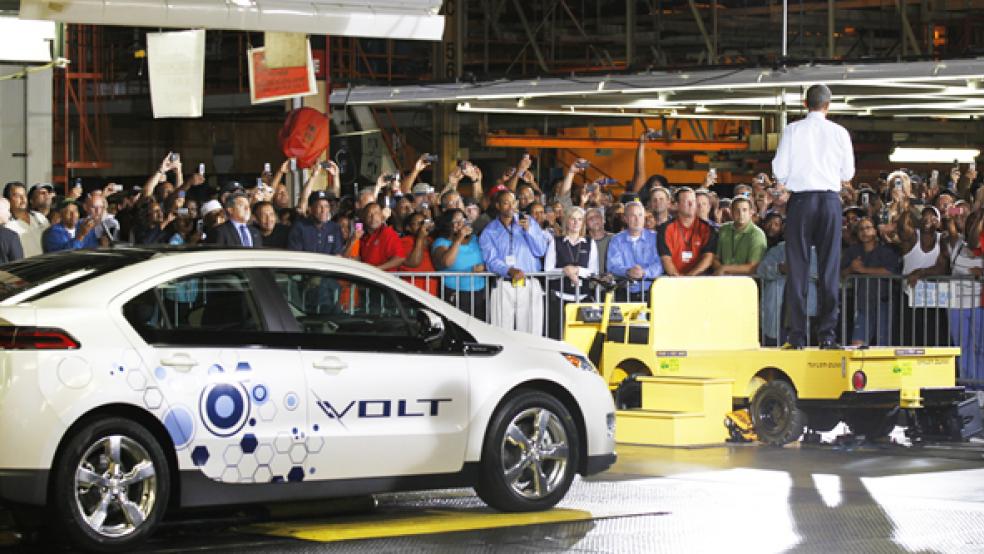American baby boomers fondly recall the day they took their first spin in a souped-up Mustang or borrowed their dad’s GTO. In contrast, Russians probably don’t wax nostalgic over their first encounter with a Moskvich or a Zaporozhets. Those forgettable cars produced in the Soviet Union were lunkish, slow and unreliable. Short on style and long on Central Planning, they failed to excite consumers, who flocked to buy U.S. and European-made vehicles the minute they could.
As recently as 2010, according to the Coalition for U.S. - Russia Trade, 34 percent of the cars sold in Russia were imported and foreign companies manufactured another 34 percent in Russia. This, despite the government’s best efforts to prop up sales and fend off competition with hefty subsidies and tariffs.
Sound familiar? In the U.S., the White House has astoundingly ripped a page from the Soviet playbook, promoting a product deemed worthy by our government overseers, but spurned by consumers. The Chevy Volt is struggling, despite Herculean efforts by the Obama administration to encourage sales – efforts estimated by the Mackinac Center for Public Policy at $250,000 per unit sold to date. General Motors, which has dubbed the Volt its “magnet around everything we are trying to do to showcase our brand,” announced last week that it was idling production of its electric car for several weeks due to poor sales and the need to rebalance inventories.
RELATED: As Gas Spikes, Car Buyers Focus on Fuel Efficiency
What’s the problem? First, the cost. The price tag is north of $40,000 – so high that the government has stepped in to soften the blow by providing buyers a tax credit of up to $7,500. In his 2013 budget, which called for the fourth trillion-dollar deficit in as many years, President Obama proposed actually raising that subsidy to as much as $10,000 for Volts and other new-tech cars – a plan that could cost $10 billion if he succeeds in his stated goal of launching one million electric cars by 2015.
Other problems: Apartment dwellers and other urban homeowners without their own garages and electric docking stations can't own electric vehicles. They park on the street or in public garages, which don't offer electric outlets. Consumers aren’t crazy about the poor visibility, the small size (the Volt only fits four people) and the car’s tricky braking system. Moreover, it turns out that if the temperature drops, you’re busted.
Using the heater significantly lowers the car’s range. That’s significant, since the car can only go about 35 miles before it exhausts its charge, at which point it switches over to a gasoline engine. Unhappily, the competitive Nissan Leaf runs rings around the Volt – it’s bigger, has some nifty features like heated seats that are standard (while special order on the Volt), and has better visibility.
GM sold 7,671 Volts last year, failing to meet its goal of 10,000 units; an earlier target of 45,000 sales in 2012 appears unlikely. (They have wisely ditched making further sales estimates.) The sales shortfall is in spite of booming overall auto demand, soaring gasoline prices, hefty purchases from the government – which has to date bought about one fifth of total production – and the helpful decision by California authorities to allow newly engineered low-emission Volts in the carpool lanes.
One might reasonably ask, “If not now, when?” Slipping sales even received a boost recently from President Obama, who announced his intention to buy a Volt when he steps down from office. He said, “I’ll bet it drives real good.” Aside from the lamentable grammar, the president’s pitch was awkwardly timed, coming just before the announced plant closing.
In fairness, safety concerns slowed sales, as the National Highway Traffic Safety Administration reported three fires caused during tests. That issue, though, has now been resolved, with NHTSA closing its investigation, concluding that the Volt did not “pose a greater risk of fire than gasoline-powered vehicles.”
Notwithstanding the tepid response from would-be buyers, President Obama’s faith in the future of electric cars is unshaken. His most recent proposal to increase subsidies reveals not only his continuing enthusiasm, but also his lack of respect for the power of the marketplace. It also reflects his need for success in Detroit. To counter rivals who charge the administration with heavy-handed and possibly illegal intervention in the finances of automakers Chrysler and GM, Mr. Obama must portray the bailout of the auto industry as a victory for American workers.
Voters are torn; while they despise TARP – the funds directed towards propping up Wall Street, most of which has been repaid – they are more forgiving of the support directed to the auto industry. Most people blame the banks for their substantial role in the financial crisis and ensuing recession, and don’t think they should have been “saved” by taxpayers. Detroit, on the other hand, and its many union workers, is viewed as innocent victims of the crash.
There is some merit to this distinction. While Mitt Romney and others can reasonably argue that the government’s heavy-handed reordering of auto makers Chrysler and GM was contradictory to established bankruptcy laws, most Americans see a restructured and surviving auto industry as a plus. But, if the funds spent to ensure carmakers’ survival are summed up...
- $86 billion in bailouts of GM, Chrysler and Ally Financial (the former GMAC)
- Cash for Clunkers
- The Warranty Commitment Program
- The Supplier Support program
- $41.5 billion in TALF backing for auto finance companies
- $106 million to support GM’s battery production for the Volt
- Other loans from the Department of Energy
- Research monies for the Advanced Research Projects Agency
...the underwriting of Detroit becomes less defensible. Through that prism, voters may come to see throwing more money at the Volt as just plain ludicrous.






